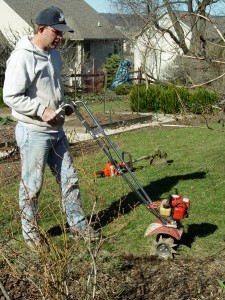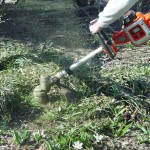Clean-up in High Gear
March 17th, 2010
Who needs a health club when you’re a gardener in March?
I sure hope you all are burning calories in the glorious weather (finally!) We needed this to start whipping the landscape back into shape after the gardener-unfriendly winter. Just don’t hurt your back!
Although I was out edging in the rain last Sunday, it’s been perfect ever since to get all kinds of stuff done. Here’s a rundown of what I’ve been doing to help you figure out what you should be doing (or not doing) in your own yards…
1.) Edging all the beds. The ground is soft now, which makes this job easy. I use a combination of an ice-chopper, a hoe and my handy-dandy Mantis tiller, fitted with a wheel and edging blade. Let a lip of about 2 inches to contain the mulch to be added in a few weeks. Of all the yard jobs, this really makes things look manicured.
2.) Prune. The bulk of my plants get it now. I’ve already trimmed the hollies, nandina and boxwoods; pruned the apple and pear trees; thinned out the snowbell tree; shortened long arms on a goldthread cypress and ‘Gold Lace’ juniper; cut the red-twig dogwoods and ornamental grasses to stubs, and cut back the summer-blooming spirea, roses, caryopteris and butterfly bush. It’s all on piles ready to be chipped into mulch that goes back on my beds. Winter left surprisingly little damage.
3.) Perennial cleanup. I don’t do much fall cleanup. Leaves make good winter insulation, and so does the dead foliage of the plants themselves. But now’s when I get out there and remove last year’s browned-out foliage of things like sedum, daylilies, mums, coneflowers, coreopsis, salvia, leadwort, etc. Although liriope is still green, it’ll brown after new growth emerges, so I just got done whacking all of mine to stubs with a rechargeable battery-operated string trimmer. For semi-evergreen perennials such as hardy geraniums, coralbells, ajuga and lamium, I just rake out the leaves and ratty foliage. All of this residue gets tossed in my compost bins.
4.) Leaf and lawn cleanup. I still don’t clean every last leaf out of the garden beds (I’ll just mulch over top), but I do rake out bigger piles or thick mats that threaten to hinder emerging bulbs and perennial foliage. I also raked scattered leaf mattings off my lawn, and this year I raked off a few patches of dead blades caused by snow mold – a result of the long-melting snowcover. That all got composted, too.
5.) Lawn work. I scattered 10 pounds of Greenview Fairway Classic grass seed over bare and thin spots in the lawn and roughed it in with a leaf rake. This is one of the best seed blends you can get in stores, which tend to carry cheapo stuff since most people think grass is grass and buy based on price. I found Fairway Classic at Stauffer’s of Kissel Hill. You’ll pay a few bucks more, but I think the better performance is worth it. After seeding, I put down a spring fertilizer. I used Espoma Lawn Food, a mostly organic granular product.
6.) Veggies at the ready. I bought a bag of ‘Red Norland’ seed potatoes and a supply of ‘Stuttgarter’ onion sets at Ashcombe’s to go in the vegetable garden by the end of March. I wasn’t the only one. Early sales are off to a great start. The day I was there, the 5-pound bags of ‘Yukon Gold’ potatoes were gone. My basement-grown seedlings of cabbage, leeks, broccoli, cauliflower and lettuce also will be going outside shortly to begin hardening off and then into the garden by the first week of April.
7.) Oil on the fruit trees. The dormant-oil spray is usually on the fruit trees by now, but the snow delayed that one until now. Oil smothers overwintering bug eggs.
Gotta go now to transplant my tomato seedlings…









